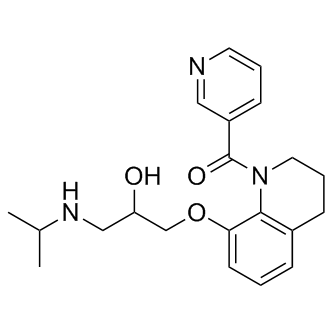
Nicainoprol
CAS No. 76252-06-7
Nicainoprol( RU-42924 | CAS-924 )
Catalog No. M15894 CAS No. 76252-06-7
A sodium channels blocker, adrenergic receptor antagonist and class 1 antiarrhythmic agent.
Purity : >98% (HPLC)
 COA
COA
 Datasheet
Datasheet
 HNMR
HNMR
 HPLC
HPLC
 MSDS
MSDS
 Handing Instructions
Handing Instructions
| Size | Price / USD | Stock | Quantity |
| 5MG | 399 | In Stock |


|
| 10MG | 588 | In Stock |


|
| 25MG | 888 | In Stock |


|
| 50MG | 1251 | In Stock |


|
| 100MG | 1692 | In Stock |


|
| 200MG | Get Quote | In Stock |


|
| 500MG | Get Quote | In Stock |


|
| 1G | Get Quote | In Stock |


|
Biological Information
-
Product NameNicainoprol
-
NoteResearch use only, not for human use.
-
Brief DescriptionA sodium channels blocker, adrenergic receptor antagonist and class 1 antiarrhythmic agent.
-
DescriptionA sodium channels blocker, adrenergic receptor antagonist and class 1 antiarrhythmic agent.Heart Arrhythmia Discontinued.
-
In VitroThe antiarrhythmic agent Nicainoprol, a fast-sodium-channel blocking drug, also protected isolated rat hearts against reperfusion arrhythmias, but is without beneficial effects on cardiac hemodynamics and biochemical parameters, in contrast to the ACE inhibitor.
-
In VivoThe effect of the novel antiarrhythmic agent Nicainoprol on coronary occlusion and reperfusion arrhythmia is investigated in isolated working rat hearts and in anesthetized rats. In isolated working rat hearts Nicainoprol (10 μM, 5 μM and 100 μM) induces concentration-related protection against reperfusion arrhythmia without changing the cardiodynamics, with the exception of a decrease in heart rate at the highest concentration. Enzyme levels (lactate dehydrogenase and creatine kinase) in the coronary venous effluent, and cardiac tissue concentrations of glycogen, lactate, ATP and creatine phosphate are not affected by Nicainoprol. Given to anesthetized rats, Nicainoprol (5 and 10 mg/kg i.v.) reduces dose dependently in the early post occlusion (0-30 min) period, the percentage of animals with premature ventricular complexes (PVCs) and ventricular tachycardia while completely preventing the occurrence of ventricular fibrillation. In the reperfusion period no animal treated with 5 mg/kg and 12% of the rats treated with 10 mg/kg showed PVCs (the only form of arrhythmia observed in this period) versus 60% of the control rats. Both doses of Nicainoprol induces a decrease in heart rate, blood pressure and myocardial oxygen consumption. The ratio of infarct mass to ventricular mass is significantly reduced by 20% at a dose of 5 mg/kg and by 28% at the dose of 10 mg/kg. Nicainoprol could be useful in the prevention and treatment of arrhythmias associated with acute myocardial infarction.
-
SynonymsRU-42924 | CAS-924
-
PathwayMembrane Transporter/Ion Channel
-
TargetSodium Channel
-
RecptorSodium Channel
-
Research AreaCardiovascular Disease
-
IndicationHeart Arrhythmia
Chemical Information
-
CAS Number76252-06-7
-
Formula Weight369.4574
-
Molecular FormulaC21H27N3O3
-
Purity>98% (HPLC)
-
SolubilityDMSO: ≥ 29 mg/mL
-
SMILESO=C(N1CCCC2=C1C(OCC(O)CNC(C)C)=CC=C2)C3=CN=CC=C3
-
Chemical NameMethanone, [3,4-dihydro-8-[2-hydroxy-3-[(1-methylethyl)amino]propoxy]-1(2H)-quinolinyl]-3-pyridinyl-
Shipping & Storage Information
-
Storage(-20℃)
-
ShippingWith Ice Pack
-
Stability≥ 2 years
Reference
1. Martorana PA, et al. Eur J Pharmacol. 1987 Nov 17;143(3):391-401.
2. Hashimoto K, et al. Jpn J Pharmacol. 1989 Feb;49(2):245-54.
3. Weirich J, et al. J Cardiovasc Pharmacol. 1988 Dec;12(6):664-71.
molnova catalog



related products
-
Transcainide
Transcainide(R 54718), a new lidocaine analog, is an orally active antiarrhythmic agent.Transcainide blocks the open state of BTX-activated sodium channels in bovine heart and rat skeletal muscle.
-
Procaine
Procaine is a local anesthetic drug of the amino ester group, which acts through multiple targets.
-
R 56865
R 56865 is a weak potential-operated channel inhibitor that inhibits the late sodium current in human isolated cardiomyocytes.



 Cart
Cart
 sales@molnova.com
sales@molnova.com


